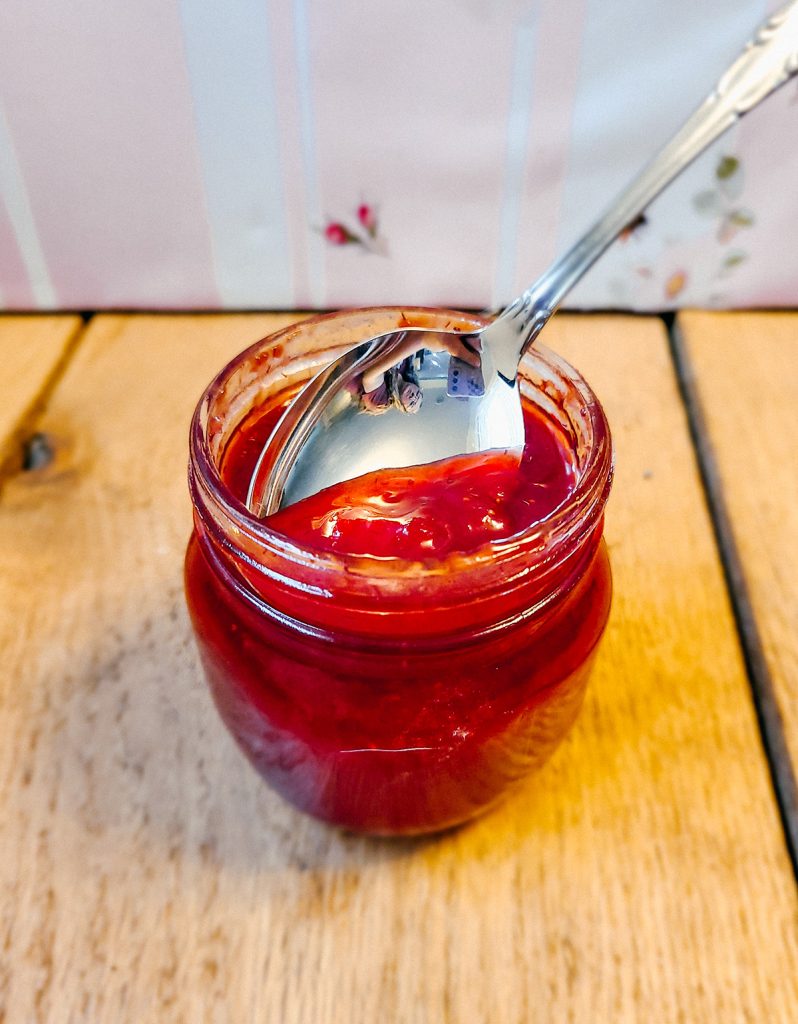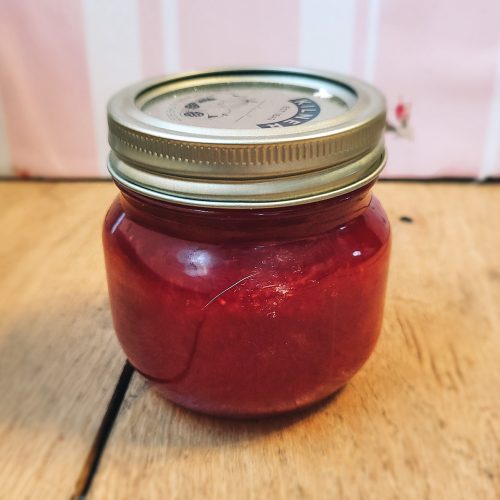This summer has been a little bit lack-luster. Between the drought and the smoke (and lets not forget the gypsy moth invasion) it hasn’t even been pleasant to BE outside much. The dry conditions also meant that one of my favorite summer fruits, strawberries, were a little scarce on the ground. Especially the good ones. But I finally found one vendor at the famer’s market who had flats of Jewel (one of the better varieties that isn’t as overly firm as some of the commercial berries), and that I wouldn’t need to sell any precious metal dental work to afford.
Jump to RecipeJewel, being a variety bred for flavor, not sturdiness, needs to be processed within about 24 hours. I had some cut up for shortcake (I recommend my cream biscuits for the shortcake part), and let the girls eat some fresh. And then I started to pull things together to make some jam. At which point, I discovered that I didn’t have any Sure-Jel. None. And a quick run out to the local stores demonstrated that everybody else was ALSO making strawberry jam. I am nothing, if not able to adapt. While I didn’t find any Sure-Jel, I DID find some cute little Kilner jam jars on sale. I’m a magpie. And I love jars. So of course these came home with me to join the collection.

Powdered (or liquid) pectin is nothing but a convenient way to both speed up jam and jelly making, and to take a lot of the guesswork out of it. Instead of assessing when your jam has reached the jellying point, you combine very specific standardized ingredients and cook it for a specified amount of time.
But it’s entirely possible to make jam or jelly without it. Some fruits can simply be cooked with enough sugar and acid to gel on their own. Strawberries usually WILL do this. However, it takes a lot longer to cook the jam down, and much of the fresh berry flavor gets lost.
This recipe has less sugar and more lemon juice than most. And adds a grated apple. It has less sugar because I like my jam that way. The lemon juice is partially their to provide acid, and partly because I like the tartness. Note that lemon juice does not add an appreciable amount of pectin to your jam. But an acid enviroment does improve the gelling power of the pectin you DO have. The apple, on the other hand, is there to provide pectin. And a bit of malic acid, which is a different sort of tart. Depth of flavor improvement, basically. Choose a variety good for applesauce, and the grated apple will cook down and disappear more readily.

Strawberry Lemonade Jam
Ingredients
- 6 c mashed fresh strawberries
- 4 c sugar
- ¾ c fresh lemon juice
- 1 fresh apple, peeled and grated
- 1 Tbsp unsalted butter Reduces foaming
Instructions
- Combine the ingredients in a large pot or preserving pan. Cook over medium heat. Skim off foam as it appears.
- Place a small plate in the freezer, while your jam is cooking
- Continue to cook, stirring constantly. Gradually, the foaming will subside and bubbles will start to become larger and thicker. At this point, the jam should start to sheet off a metal spoon.
- Test to see if you have reaching the jellying point by placing a small amount of jam on the frozen plate, and then turning the plate to allow the jam to "run." If it runs only very slowly, you have cooked your jam enough.
- Place the hot jam in sterilized jars.
Notes
Disclaimer: Because we live in a litigious society, I must point out that this is not a USDA-approved recipe for preserving. So, the end product will last a few weeks in the refrigerator. Like most things on this blog, I am assuming that you either have a certain level of experience to draw on. Or that you can consult one of the many excellent sources for beginner jam making. If you DO have some experience, you can probably figure out how to can your jam without my help. And also to understand the relative risks of jam made with fresh lemon juice – which is less consistent in acid level than the bottled, but tastes better. The resulting jam is somewhat soft set, but retains some of the fresh berry flavor.
Oh, and if you need some visuals on what the jellying point looks like, visit my post on Honeyberry Jam.
Just to motivate you, one of my favorite ways to use this jam is to toast an English muffin, butter it lightly, add jam, and a small dollop of whipped cream (with a bit of almond extract in it).
